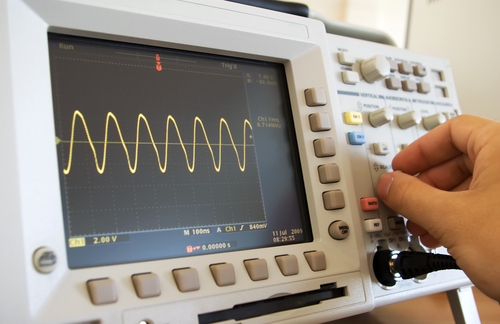Frequency
The frequency of a wave is the number of vibrations in one second. It is measured in Hertz.
Low-pitched, deep sounds have low frequencies, while high-pitched 'squeaky' sounds have high frequencies.

An oscilloscope is a device that can show a sound's wavelength on a screen. The closer together the waves, the higher the frequency.
Human hearing
A sound wave is just particles vibrating. Our ears 'catch' this sound, which is why we can hear things. But how does the ear actually work?
First, let's understand that you can divide the ear into three parts: the outer ear, the middle ear, and the inner ear.
.jpg)
Now, let's begin with the sound wave forcing air particles to vibrate in a longitudinal wave. These particles will bunch up and spread out, knocking into each other, passing the sound from one place to another. Once the air particles near our ears start vibrating, your outer ear captures that sound by vibrating. This vibration is then passed down the ear canal.
The ear canal is inside your head. It is still part of the outer ear and just full of air, so the vibrations continue to travel to the ear drum. This is where the middle ear begins.
The ear drum is a tiny membrane that vibrates, passing the vibrations through tiny bones (incus, stapes, and malleus on the diagram above), and into the cochlea (which is taken from the Latin for 'snail shell', and looking at it on the diagram, you can see why it got its name!). The cochlea is full of fluid and it helps your brain to understand the concept of feeling balanced, so this fluid being swirled around is the reason you get dizzy if you spin or run in a circle.
Finally, the vibrations pass down the eustachian tube and into the brain, which makes sense of the sound. So the entire process is just a series of vibrations passing through numerous parts of your ear. It is a far more complex organ than people realise!
What can we hear?
Everyone has a slightly different hearing ability, but there are certain frequencies that no human can hear. This is because the ear drum will not vibrate if a frequency is too high or too low, meaning the vibrations cannot be passed into the middle ear and on to the brain.
The range of human hearing is 20 Hz to 20,000 Hz. Humans cannot hear anything below 20 Hz or anything above 20,000 Hz. Any frequencies below 20 Hz are called infrasound and any frequencies above 20,000 Hz are called ultrasound.
What can animals hear?
The chart below shows the hearing ranges of different mammals.

Different species of animals have different hearing ranges to humans. Some can hear frequencies lower than 20 Hz, while others can hear above 20,000 Hz. Some species can do both.
A dog whistle is an example of this. A person blowing into a dog whistle cannot hear it make a sound, as its frequency is so high, but a dog will respond to it.

Are you ready to test out what you know about sound in the following questions?








